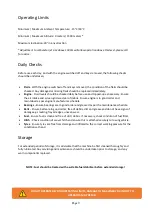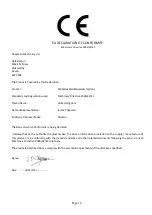
Page 14
Flail Condition & Replacement
Over time, the flails on your machine will wear, and performance will deteriorate. It is important that the flails are
kept in good condition to ensure a long service life of your machine. Flails should be replaced when either; 3mm
has worn off the end of the flail; the flail has become blunt or damaged; flails are missing.
When replacing flails the diametrically opposite flail should be replaced at the same time in order to maintain rotor
balance, When flails are fitted in pairs, (e.g. Y Grass Flails), both must be replaced at the same time. As flails are
fitted in a spiral pattern care must be taken to replace the correct diametrically opposite flails.
When replacing flails visually inspect the mounting bolts and bushes, if applicable. These are all wearing part and
normally should be replaced at the same time as the flails.
Troubleshooting
Problem
Possible Causes
Remedies
Irregular Cut
Worn, bent or broken flails
Inspect & replace & damaged flails
RPM too low
Always use maximum throttle
Machine not level to the ground
Check & adjust tyre pressures
Clogged material caused by exces- sive
forward speed
Reduce forward speed
Excessive Machine Noise
Unbalanced Rotor
Check flails & replace any damaged flails. If
vibration persists, see
“vibration”
below
Loose bolts
Check bolts & tighten as necessary
Damaged components
Repair or replace
Excessive Engine Noise
Worn muffler
repair or replace
Engine problems
Consult authorized dealer or
Chapman Machinery
Excessive Belt Noise
Belts slipping
Adjust belt tensioner
Belts worn
Replace belts
Vibration
Worn, bent or broken flails
Inspect and replace as necessary
Rotor out of balance
Balance or replace rotor
Worn rotor bearings
Replace rotor bearings
Excessive movement of drawbar
Worn drawbar pins
Replace drawbar pins
Loose drawbar hand screws
Tighten hand screws
Bearings tight or overheating
Bearings dirty or ungreased
Clean & grease bearings
Bearings worn to excess
Replace bearings
Belts Overheating
Belts slipping on pulleys
Tension belts
Flails contacting the ground
Raise cutting height
Working speed too high
Reduce forward speed
Machine Disposal
Disposal of this machine and any of its component parts must be performed in a responsible and inoffensive
manner respecting all current laws relating to this subject. Materials forming this machine that must undergo
differentiated division and disposal are:
Steel, Mineral Oil, Rubber & Plastic


































